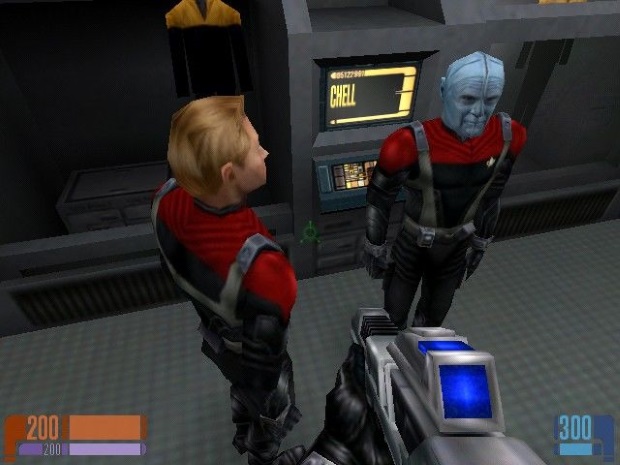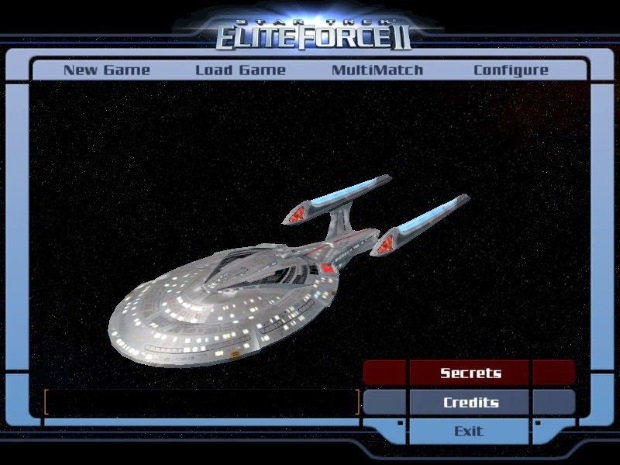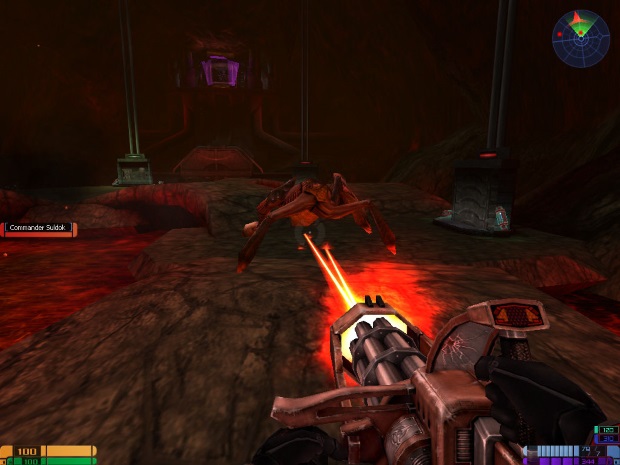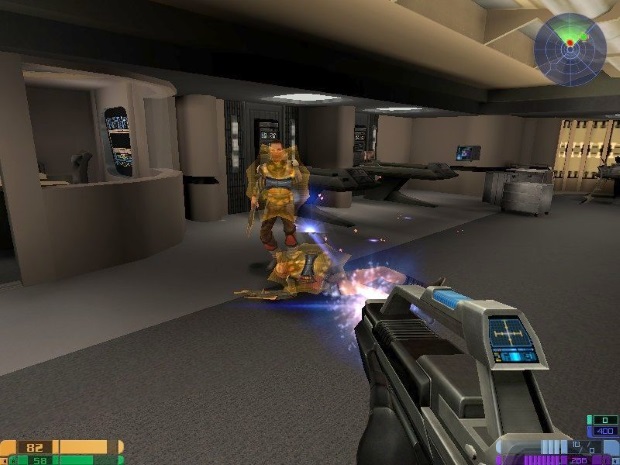Star Trek: The Activision Years and the Making of Elite Force I & II
We look at the story behind some of the finest Star Trek videogames to date: Elite Force, and its sequel...
This article comes from Den of Geek UK.
And it had all started so well. When Activision and Viacom signed their agreement in mid-1998, Star Trek was going strong. Both Deep Space Nine and Voyager were on the air, the Next Generation crew had enjoyed a huge hit in theatres with First Contact. Insurrection was on the verge of release. Expectations of the deal were high. The New York Times estimated that it could generate $600 million in retail sales. It was heralded as an unprecedented agreement granting Activision the right to make and sell videogames based on the Star Trek franchise for 10 years.
But only five years and ten published games later, Activision and franchise-owner Viacom were suing each other, each accused of breaching the agreement.
Although the deal was therefore cut short, the Activision era of Star Trek videogames was nevertheless full of gems that even today are considered among the very best that the franchise has to offer gamers. This is the story of two of them, Star Trek: Voyager – Elite Force and Star Trek: Elite Force II.
First-person shooting in a Star Trek setting

“The best diplomat I know is a fully-activated phaser bank” – Montgomery Scott, 2267
The first game by Activision was Presto Studios’ rushed sequel to the Insurrection film, Hidden Evil, released to negative reviews in 1999. It was soon followed by Armada (a warmly-received real-time strategy game from 2000), the all-but-forgotten ConQuest Online, and the Colony Wars clone for PS1, Invasion.
But the publisher also wanted a Star Trek first-person shooter. To create it, Activision turned to its newly-acquired studio Raven Software, known for the Heretic and Hexen titles.
“My initial reaction was, ‘You can’t make Star Trek a first person shooter!’,” remembers Raven’s Michael Chang Gummelt. “That kind of constant, mindless action just didn’t fit Star Trek. I couldn’t even imagine Captain Kirk running around blasting scores of enemies with a phaser rifle for hours on end.”
“We went out of our way to make sure that the shooting parts felt justified,” he says. “We even had a couple [of] Star Trek-like twists in there, like the Etherian level, that kind of addresses that concern even within the context of the story.”
Although for Gummelt the games that best captured the Star Trek spirit were Interplay’s 25th Anniversary and Judgment Rites, “we did the best we could within the confines of the genre we were working in, I think.”
“Most of the team were Star Trek fans,” recalls the game’s project lead Brian Pelletier. “And I too grew up watching and playing Trek with my brothers and friends.”
“We still did a fair amount of research and I visited Paramount several times,” he adds. Pelletier mined their archives, saw the Voyager sets, and spoke with the show’s art staff.
The idea was conceived by Raven co-founder Steve Raffel. “It was a story he had been working on for a prior game that was cancelled and it fit really well,” says Pelletier. “We needed a believable reason within a Star Trek setting for a combat squad. It didn’t make sense to use the stars of the show, who are high-ranking and critical to running Voyager, as soldiers… So the Hazard Team idea seemed a logical device to balance a shooter game mentality with Star Trek sensibilities.”
Originally, the Hazard Team was to be founded by The Next Generation’s Worf, but the setting shifted to Voyager during development and Tuvok took on Worf’s responsibilities.
Gummelt is credited with the screenplay. “I was working full time, or more, as a programmer on Elite Force, so all the writing I did was after hours at home,” he reminisces. Gummelt had previously written Star Trek fan fiction and it was agreed that he should have a go at writing the game. He would go on to have a hand in all aspects of story development and level design, from storyboarding through to the voice recording sessions. “Ultimately I wrote 800 pages of dialogue for Elite Force,” and being a programmer, he argues, helped because he knew how the voiceovers would be integrated into the game. It all really was “a dream come true” for Gummelt, “to basically come up with my own Star Trek crew!”
This crew, along with the renowned bridge officers of the starship Voyager, become trapped in a mysterious region of space known as the Forge. They are not alone, for Hirogen, Malons, Klingons, and Borg are all trapped with them. Voyager must escape before it is taken apart by scavengers or falls victim to the evil plans of the dangerous and mysterious Vohrsoth.
There are similarities between Elite Force and the Animated Series episode The Time Trap, which Gummelt does not remember seeing until later. “I think both that episode and our story were obviously influenced by the same idea: the Bermuda Triangle and the Sargasso Sea,” he says.
The narrative provided logical reasons for Voyager to encounter Klingons. Thrillingly, the unusual setting also allows players to board and explore a Mirror Universe Constitution-class vessel of the TOS era. “That… was tricky legally because Activision didn’t have the rights to TOS games,” says Gummelt. As part of an earlier agreement, Interplay held those rights until 2002. “But I think they worked out a deal where they could use it.”
“Paramount approved these because they fit logically into the story and didn’t mess with the established history,” Pelletier explains. “We decided right away that we wanted to include numerous identifiable Trek visuals for a greater sense of immersion in the Trek universe.”
“The weapons, the tricorder, the ship, the enemies, the characters. It felt like Star Trek. It was so much more than just an FPS with Star Trek trappings,” enthuses Gummelt.
“My favorite aspect of the game,” Pelletier states, “was during the down times between missions, where I could wander around Voyager and talk to other characters. I found it enjoyable getting to know their personalities. This was so different from any other real-time game at that time.”
Characters old and new

“Is the crew always this difficult?” – The Doctor, 2371
The success of the game depended on its characters as much as the environments. “We couldn’t add aliens to the ship that the show hadn’t already shown,” Gummelt laments, “which was frustrating for me as I was trying to create a diverse crew. I had a Deltan, an Orion, and an Andorian in the Hazard Team at one point, if I recall. Those ended up becoming Jurot ([from] Betazed), Telsia (Human), and Chell (Bolian).” Chell was a character carried over from the live-action series in which he had a minor role.
“I really wanted diversity in the personalities, so wrote bios on all of them,” Gummelt continues. “Chell was the nervous, insecure one; Chang was the quiet stoic but deep-thinker; Jurot was an interesting mix of Vulcan stoicism and Betazed empathy; Foster was the good soldier, by-the-book; Biessman was the loud-mouth braggart and bully; Telsia was tough and stubborn and passionate; and Munro was the talented risk-taker and natural leader.”
“The interactions, banter, and relationships between these characters was my favourite part of writing Elite Force,” says Gummelt. “If you walked around and listened to the conversations they were having and talked to everyone, you could get a good feel for how they were reacting to the events in the story, how they felt about you and each other. For instance, if you listen, you can tell that Chang and Jurot were developing a romantic relationship together. And, of course, Telsia and Munro were falling for each other as well.”
In that regard, the Star Trek of videogames was bolder than the Star Trek of film and TV often proved to be. “I’m very proud that we went ahead with the decision to let you play as a male or female protagonist,” Gummelt says. “Most games at the time weren’t doing this and it was a lot of extra work. But Raven and Paramount all backed us on this – and, in the spirit of Star Trek, were fine with letting the romance with Telsia be either heterosexual or homosexual depending on your gender choice.”
As for writing the established characters from the series, such as Tuvok and his determined captain, Kathryn Janeway, “I felt like I knew the characters so well already,” says Gummelt. “It just came naturally.”
All of the leads bar Jeri Ryan leant their voices to the game, though Ryan’s was added later as part of the Virtual Voyager expansion pack that also allowed for freer exploration of the ship.
“They all knew their parts perfectly and needed no direction other than us letting them know the context of the scene,” Gummelt relates. “And I even got a few compliments from some of the cast members about my writing. One even said I should come write for the show, which was pretty cool.”
Pushing the technology

“I’m giving her all she’s got, Captain!” – Montgomery Scott, 2258
“Originally we were going to do it in eighteen to twenty-four months,” recalls Gummelt, “but I think we needed a six-month extension. It was more difficult than other games because this was the first time we would be using the Quake III engine.”
Since Quake III was a multiplayer game, the programming team led by James Monroe added an entire single-player engine onto the Quake III foundation. On top of that, Joshua Weier and Gummelt wrote from scratch the language used by the designers to script the events and cinematics.
“I wrote a camera system that you would control like a director,” explains Gummelt. It would be, “Give me a tracking medium shot of these two characters as they walk down this hallway,” rather than, “Place camera at XYZ with an angle of P,Y,R.”
There were other challenges. “A limitation we had was lip syncing,” says Pelletier. “We had a lot of talking characters and the real-time character models, although advanced for the time, were still too limited for creating mesh facial animations and in our early tests they looked like muppets talking. Our solution was creating a series of face textures for all characters that had mouth movements and facial expressions to play as 2D animations on the head, synced by the voice actor audio files.”
Yet the “biggest challenge” according to Pelletier was the AI for the away team. “We had a lot of trial-and-error to find the right balance to make them act smart and natural, like following you, and getting out of your way, being able to detect enemies and shoot at them (but not be too good that the player has nothing to shoot at).”
Not every challenge was overcome. “My least favorite thing were some of the boss battles,” Gummelt reveals. “I don’t think they turned out as good as we would have liked, to be honest.”
Release and reaction

“It was… fun” – James T. Kirk, 2371
Elite Force was released on PC in September 2000 to an excellent reception from critics and fans. “I was expecting better sales than what we got,” admits Pelletier. But sales were good.
The game was accompanied by a loose comic book adaptation and, later, a PS2 port undertaken by Pipe Dream Interactive in 2001.
“The PC is its true form,” says Pelletier. “I didn’t have much expectation for the console port, but was pleasantly surprised with how well it turned out considering the challenge.”
Gummelt is less equivocal: “The PC version was absolutely superior. The PS2 port just couldn’t do everything we could do in the PC version.”
However it was played, the game quickly became a favorite of many among the plethora of Star Trek titles. Pelletier credits “the dedication of an amazing development team and producers who were passionate about Star Trek, and our driving goal of creating something fans and non-fans would enjoy.”
Activision subsequently released the Star Trek games Away Team (2001), Armada II (2001), Bridge Commander (2002), and Starfleet Command III (2002) – all, with the exception of Away Team, highly-regarded. But they also pursued rounding up the Hazard Team for another adventure.
A second outing

“You really want to head back out there, huh?” Leonard McCoy, 2263
Raven was busy with Jedi Knight II and so Activision went in search of another developer for the Elite Force sequel. Chris Stockman worked at Ritual Entertainment in Dallas, across the hall from the company which Activision had gone to see. “That studio’s leadership,” Stockman recalls, “had made everyone dress up in Starfleet uniforms to illustrate to them how hardcore they were. That stunt backfired.” When the meeting was over, Activision “walked across the hall and, basically, offered it to us on the spot. We still had to go through the usual pitch process, but the game was basically ours if we wanted it.”
And they did. “When I found out Activision was looking for someone to take the reins of Elite Force,” says Ritual’s Jon Galloway, “I knew I had to try to be that guy! So I worked really hard on a pitch – with help, of course.” Already a fan, Galloway nevertheless spent the next eighteen months watching every episode of every series at least twice.
In preparation, Stockman, who became design lead on the project, played through the first game “multiple times to really digest how Raven had tackled the IP”. But settling on the story wasn’t easy.
Like the Raven team before him, Galloway (the game’s project lead) had to reconcile the FPS tradition with Star Trek’s peaceful ethos. “Everyone had their own ideas of how it should work – and a few that were pretty adamant that it shouldn’t work. I actually tried to get them to make more of an ‘Action Adventure’-style game,” he says, referencing Uncharted. “But nobody wanted that much of a departure from the original.”
The first story Galloway got approved, he says, “was about a group of Federation separatists who stole a starship and crashed it into Starfleet Academy.” He wanted it to be M-rated. Outside events intervened. “9/11 happened and some people involved with the project got spooked with the idea and similarities, and we were forced to rip it apart and quickly recraft a whole new story.” This was to be, as Galloway describes it, “a much safer, Teen-rated story with some kind of mass-produced baddies so we weren’t killing what looked like humans for the entire game.”
“I mean, I get it, sort of,” Galloway explains. “The Star Trek license was expensive, so you need to play it safe and just make some fun games that appeal to a wider audience.”
With deadlines looming, Activision brought in an outside writer to help the team. Together, they fashioned a story which would take the Hazard Team from Voyager to the Enterprise-E, just in time to help the legendary Captain Jean-Luc Picard navigate his way through an interplanetary dispute and a Romulan plot.
Taking place after the events of the 2002 movie Star Trek: Nemesis, the Enterprise is missing the characters of Riker, Troi, and Data, all for obvious reasons. Yet, B-4, Dr Crusher, Worf, and La Forge are also absent.
“We had zero knowledge of the Nemesis story during development,” Stockman says. Activision “basically told us who we had access to”.
“Some of the story was worked around who we were able to get signed-on,” Galloway explains. Patrick Stewart was attached from the beginning. “In the game, he sounds like the Captain Picard we all know and love, so I always felt like he had put himself into the role.”
“Patrick Stewart was incredibly professional and a pleasure to work with,” Stockman remembers. “So was Dwight Schultz, Tony Todd, and the rest of the cast.”
“I was so busy managing the game, I delegated the VO directing to Chris [Stockman],” Galloway shares. “I was pretty jealous – I really did want to do it.”
As for what those mass-produced enemies would be, Ritual needed something achievable in the time-frame available. “We had to work fast,” says Galloway. “We needed something we could get away with being rather dumb but in larger quantities…so it became cloned, genetically-engineered bugs made in the ruins of an ancient culture.” Galloway sees the premise as “familiar territory for Star Trek” and reminiscent of the Next Generation episode The Quality Of Life. “We have a planet which is capable of mass-producing an endless supply of increasingly-difficult enemies.”
Improving on the previous voyage

“Change is the essential process of all existence” – Spock, 2268
Just like the original, Elite Force II was built on the foundations of Quake III. “The engine was heavily modified…with enhanced particle and FX systems, and lots of animation and rendering improvements,” says Galloway. “We pushed the engine pretty hard.”
There were many new features, including minigames, added for the sake of variety. Munro now has a tricorder to play with, he can move more freely around the ship, or roam the surfaces of strange new worlds. As Galloway says, “I wanted it to feel like you were really playing a day in the life of a Starfleet officer. You wander around the ship, you engage with others – or just listen to their funny conversations – and sometimes you have to do your job, put on the red shirt, and go shoot some stuff.”
“For some people, the idea of working on a licence title is appalling and the antithesis of creativity,” says Galloway. “So I really wanted to make sure that the team could express themselves.”
This led to the inclusion of secret areas, collectible starships, and even fantastical monsters made up of wooden crates. “Chris Stockman is a huge Miyamoto and Nintendo fanboy. I am pretty sure that this influenced this particular aspect of the design,” says Galloway. “Everyone on the team got on-board and helped make adding their own little secrets a part of development.”
“I also wanted to play with the fourth wall – the idea that, at the end of the day, you are really just another actor on the Star Trek TV set,” Galloway continues. “And a few of these secrets made a nod to those ideas.”
Also new were dialogue choices. Stockman had played the No One Lives Forever games during the pre-production phase of Elite Force II and was, he says, “quite enamoured with their dialogue choice sequences. I used these sequences as inspiration for when the player interacted with the two female love interests in the game. We also changed the game’s ending slightly based on who you interacted with the most.”
One thing missing this time around, however, was the ability to play as the female Alexandria Munro. “It was talked about pretty regularly,” says Galloway, praising the original for “a pretty innovative move at the time in a white male-dominated industry.”
“And then what do they do? Turn around and hand EF2 to a bunch of perma-boys who have played too much Duke Nukem. We get frat boy Munro playing two chicks at once – one a co-worker and the other a sexy genius alien whose everyday wear is a space bikini and chiffon.
“But I think I recall the main reason being that it cost too much, considering that it didn’t add to the length of the game.”
The deal breaks down

“Don’t believe them! Don’t trust them!” – James T. Kirk, 2293
“We were pushed pretty hard to design and create a game that would score a 7.5 or better on Metacritic – and we crunched like mad to make that happen,” says Galloway. “I basically lived at the office for the last year.”
“From the story snafu early on until the day we shipped, we were very accommodating,” reveals Galloway of Activision’s demands. “We rolled with a lot of punches.” Eventually, Galloway says, he “felt kind of battered.”
It looked like it had all been worth it, with great reviews upon launch. “We met – and exceeded – all of our goals,” asserts Galloway. “I guess if I had a do-over, I would cut half the content and polish the experience more because, to be honest, there were a few things in EF2 that were a bit superfluous,” he admits. “The game wasn’t perfect. It had its flaws, but it was the very best we could do with the time and money we had.
“But then we found out that Activision didn’t even burn a lot of copies… Then, all of a sudden, we discover that Activision is suing Viacom over the Star Trek licence. What a bummer!”
Activision’s assessment was damning. “Through its actions and inactions, Viacom has let the once proud Star Trek franchise stagnate and decay,” said the remarkable statement Activision released on 1 July 2003. The company’s court filing from the day before asserted that “Activision cannot successfully develop and sell Star Trek video games without the product exploitation and support promised by Viacom.” The franchise’s latest film, Nemesis, had tanked, with no plans for future instalments. The only Trek series then on television was the much-maligned Enterprise, teetering on the brink of cancellation. Many were wondering if Star Trek, after ten feature films and nearly seven-hundred episodes, should be retired.
Despite the fact that their agreement did not commit Viacom to producing a specific amount of Trek-related content, Activision argued that Viacom was in breach of contract for not giving Star Trek proper nourishment. The games publisher considered the deal terminated and sued for damages. Viacom, for its part, denied neglecting the property and countersued. The parties settled in secret and the licence passed to other publishers.
“What it felt like,” continues Galloway, “was a conspiracy, because there was, over the years, lots of chatter that most Star Trek games were mediocre. So EF2 was a hard push: ‘Look, we can create a…[game] that is well-designed, scores well on Metacritic, gets great reviews, and has good retail marketing – but doesn’t sell! Why? Well, because the licence is stagnant, Viacom hasn’t put out any new TV shows or enough movies to keep it popular – it’s not our fault.’” For Galloway, it was a “very surprising and really frustrating” turn of events. “After all of that crunching to get it done, it was pretty deflating to have it just be dead in the water because of publishing squabbles with Hollywood.”
The consequences went further than a sense of disappointment. “We easily should have had another project and continuing success with that team,” Galloway suggests. “Instead, within weeks of launch, we had several rounds of layoffs and it was a tragedy.”
“But then again,” Galloway reflects, “that scrappy team, that had never made a game together before EF2, disbanded and those folks got propelled into successful careers… My career hasn’t suffered because of EF2’s failure. But I do carry some anguish over that game, because ultimately I was responsible for it from beginning to end, and there is so much of my DNA mixed in with its creation. It really was my weird sci-fi baby.”
Elite Force II was the last Star Trek game released under Activision’s tenure. It was a good note on which to end. “Players and fans alike,” remembers Stockman, “had incredibly-low expectations.” It made him “happy to have exceeded them in almost every way imaginable”.
“What’s craziest to me,” expresses Galloway, “is that people are still creating mods for the game! So I guess there are people out there still playing it.”